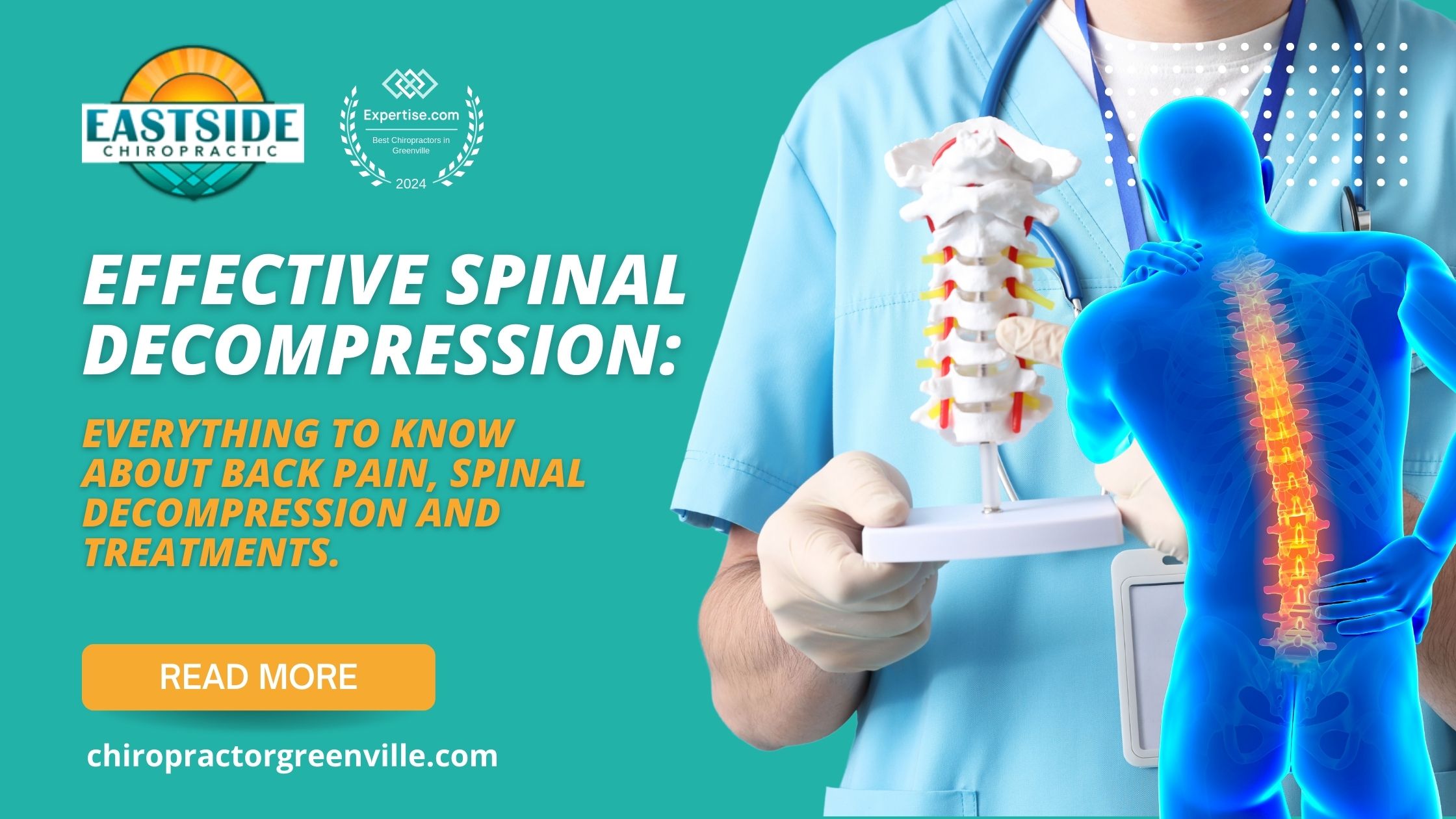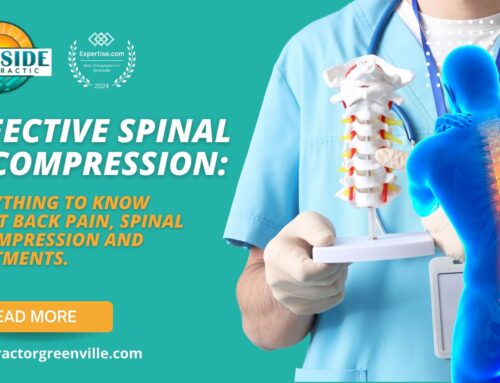Understanding Spinal Decompression for Back Pain Relief in Taylors, SC
Introduction
Back pain can be debilitating, affecting your daily activities and overall quality of life. Ensuring spinal health is critical, and one effective procedure that can offer relief is spinal decompression. This article will walk you through the benefits of spinal decompression, focusing particularly on services offered by Eastside Chiropractic PA in Taylors, SC.
What is Spinal Decompression?
Spinal decompression is a treatment designed to alleviate pressure on the spinal discs. This pressure can cause significant pain and discomfort by irritating the nerves. The procedure can be performed surgically or non-surgically.
Types: Surgical and Non-Surgical
– Surgical Spinal Decompression: Involves procedures like laminectomy or discectomy to physically remove parts of the bone or disc that are pressing on the nerves.
– Non-Surgical Spinal Decompression: Uses a motorized traction table to gently stretch the spine, altering its force and position. This allows for the retraction of herniated or bulging discs, promoting the flow of oxygen, water, and nutrient-rich fluids to heal the affected discs.
Why Choose Spinal Decompression?
Common Conditions Treated
Spinal decompression can treat a variety of conditions, including:
– Herniated discs
– Degenerative disc disease
– Sciatica
– Spinal stenosis
– General back pain
Benefits of Spinal Decompression
– Non-invasive treatment
– Lower risk compared to surgical options
– Potential for long-term relief
– Improvement in mobility and overall function
The Procedure of Spinal Decompression at Eastside Chiropractic PA
Initial Consultation
The process begins with an initial consultation to evaluate your specific needs. The chiropractor will take a detailed medical history and may recommend imaging tests like MRI or X-rays.
Treatment Plan
Based on the consultation, a personalized treatment plan is created. This plan will detail the number of sessions required and any other complementary treatments that could be beneficial.
The Decompression Process
During the procedure, you will lie on a specially designed-table. A harness is fitted around your hips, and attached to the lower part of the table near your feet. The upper part of the table remains fixed, while the lower part moves to gently stretch your spine.
Back Pain After Spinal Decompression
Some patients may experience back pain after spinal decompression. This can be due to several reasons, which are generally normal during the initial stages of healing.
Possible Causes
– Muscular adjustments as your body adapts to the changes
– Minor inflammation from the stretching process
– Temporary irritation of the nerves
Normal vs. Abnormal Pain
If the pain is mild and diminishes within a few days, it’s generally normal. However, if the pain is severe or persists beyond a reasonable period, it’s crucial to consult your chiropractor for further evaluation.
Addressing Back Pain Relief
Techniques for Managing Pain
Several methods can be employed to manage any residual pain, including:
– Ice and Heat Therapy: To reduce inflammation and promote blood flow.
– Stretching and Exercise: To strengthen the muscles supporting your spine.
– Pain Relievers: Over-the-counter medications can help manage pain temporarily.
When to Seek Additional Help
If the pain becomes unmanageable, it’s important to contact Eastside Chiropractic PA for further assessment. Early intervention can prevent complications and ensure a smooth recovery.
Patient Experiences: Testimonials and Success Stories
Real-life testimonials and case studies can often provide the reassurance you need. Here are a few words from our satisfied patients:
– “The relief I felt after my spinal decompression sessions was beyond my expectations.”
– “Eastside Chiropractic PA gave me my life back. I can now enjoy activities I had long abandoned due to back pain.”
The Science Behind Spinal Decompression
How It Works
Spinal decompression works by creating a negative pressure within the disc. This helps reposition bulging or herniated discs, reduces inflammation, and improves nutrient exchange.
Studies and Research
Numerous studies support the efficacy of spinal decompression. Research indicates significant relief in patients with chronic back pain, with improvements noted as early as the first few sessions.
Preparing for Your Spinal Decompression Treatment
What to Expect During Your Visit
On the day of your visit, ensure that you wear comfortable clothing. The staff will guide you through the procedure, ensuring you’re well-informed and comfortable.
Pre-Procedural Instructions
– Avoid heavy meals before your session.
– Hydrate well.
– Bring any previous medical records or imaging scans if you haven’t provided them already.
Post-Treatment Care for Spinal Decompression
Immediate Post-Treatment Care
After your session, you may feel some mild discomfort, which is normal. Gentle stretching and staying hydrated can help alleviate this.
Long-term Care and Maintenance
Consistency is key. Follow your chiropractor’s recommendations regarding exercises and lifestyle changes to maintain the benefits of the treatment.
Lifestyle and Dietary Recommendations
Exercises to Support Spinal Health
Regular exercises such as swimming, walking, or Pilates can strengthen your back muscles and promote spinal health.
Nutrition Tips
A balanced diet rich in vitamins and minerals supports the healing process. Foods high in omega-3 fatty acids, calcium, and vitamin D are particularly beneficial.
Common Myths About Spinal Decompression
Debunking Popular Misconceptions
– Myth: Spinal decompression is painful.
– Fact: It is generally painless, and most patients experience a gentle stretching sensation.
– Myth: The results are not long-lasting.
– Fact: With proper care and follow-up, the results can be long-term.
Comparison: Spinal Decompression vs. Other Treatments
Chiropractic Adjustments
Chiropractic adjustments focus on realigning the spine but do not specifically target disc decompression.
Physical Therapy
Physical therapy helps improve strength and mobility but may not directly address disc-related issues.
Medication
While medications can relieve pain temporarily, they do not treat the root cause of spinal problems.
Cost and Insurance Information
Pricing Structure
The cost of spinal decompression varies depending on the number of sessions required. Eastside Chiropractic PA offers affordable packages to meet different financial requirements.
Insurance Coverage
Many insurance plans cover spinal decompression as part of chiropractic care. It’s advisable to check with your provider for specific details.
Conclusion
Spinal decompression offers a viable solution to back pain, providing relief and improving quality of life. If you’re in Taylors, SC, Eastside Chiropractic PA is your go-to provider for effective spinal health solutions. Take the first step towards a pain-free life and consult with our experienced chiropractors today.
FAQs
1. How long does a spinal decompression session take?
A standard session typically takes between 30-45 minutes, depending on the individual treatment plan.
2. Is spinal decompression painful?
Spinal decompression is generally painless. Most patients experience a gentle stretching sensation during the procedure.
3. How soon can I expect results after spinal decompression?
Many patients report feeling relief after just a few sessions, but the overall outcome depends on the severity of the condition and adherence to the treatment plan.
4. Can spinal decompression be combined with other treatments?
Yes, spinal decompression is often combined with other treatments such as chiropractic adjustments and physical therapy for comprehensive care.
5. What if I have had previous back surgeries?
If you have had previous back surgeries, spinal decompression may still be an option. A thorough consultation with your chiropractor will determine its suitability for your specific condition.


